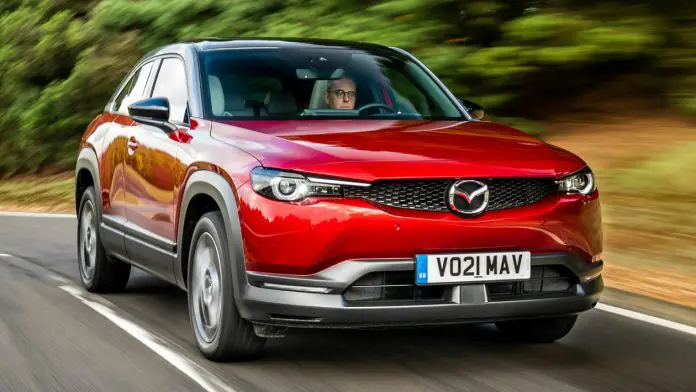More reviews
Car group tests
Long-term tests
Road tests
The rest of the MX-30 is unusual, too. Its rear-hinged rear doors hark back to Mazda’s RX-8 coupe, creating a pillarless cabin that’s a novel proposition in the modern small car market. There are also some unique uses of environmentally friendly materials, such as the cork used on the centre console, helping to underline the car’s green credentials.
The MX-30 slots into the Mazda range as an electric alternative to the CX-30 small SUV. Both are broadly the same size, but the MX-30 swaps the traditional five-door layout for that unorthodox pillarless cabin and a coupe-like roofline that tapers down to the rear. The pair occupy the level below the CX-5 mid-sized SUV in Mazda’s range.
Regarding rivals, the MX-30 theoretically goes up against other small electric SUVs like the Kia Soul EV, Vauxhall Mokka-e and Hyundai Kona Electric. However, these cars employ larger batteries that help them significantly outstrip the MX-30 in terms of range.
Using a smaller battery than most of its EV rivals means the MX-30 costs less, starting around the same level as smaller electric city cars like the Fiat 500, Honda e, and MINI Electric. However, its battery and plug-in hybrid technology make it around £6,000 more expensive than the petrol-powered CX-30.
To maintain the brand’s USP as a maker of driver’s cars, Mazda has built its electric offering around its ‘Jinba Ittai’ ethos to deliver swift reactions to driver inputs. All cars have Mazda’s G-Vectoring Control Plus, which distributes the electric motor’s torque to optimise grip, traction, and stability. That seems to have paid dividends because the MX-30 is a more sprightly drive than your average electric SUV.
The MX-30 line-up consists of three trims: Prime-Line, Exclusive-Line and Makoto. These three equipment grades are identical for the pure EV and R-EV plug-in hybrid models.
All MX-30s get LED headlamps, heated electric folding mirrors, parking sensors at both ends, a reversing camera and rain-sensing wipers. There’s an 8.8” screen for the infotainment system controlled by a simple-to-use central rotary knob and panel of buttons. If you’d rather run an app from your phone, standard Apple CarPlay and Android Auto connectivity will allow you to do so. Plus, Mazda’s Connected Services with the MyMazda app brings remote control over vehicle functions and relays charging information back to your phone.
Frequently Asked Questions
The Mazda MX-30 wouldn’t be a good choice for family car buyers due to its limited rear seat space, but it makes a fair case for itself against cheaper EVs because of its premium interior, lots of standard safety technology, and fine driving dynamics. The plug-in hybrid R-EV is much more useful because its petrol-rotary engine increases its useable range.
The pure electric Mazda MX-30 has a smaller battery than other small electric SUV rivals, so that’s the reason why its range is lower in comparison.
While the Mazda MX-30 was initially only available in electric form, a plug-in hybrid R-EV model allows you to drive up to 53 miles on electricity, and then use a petrol-powered rotary engine to increase your range up to 400 miles.









